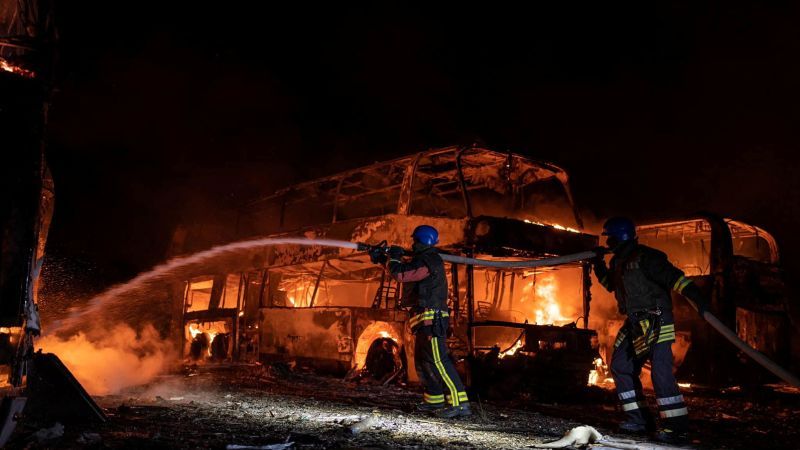How Western air defense weapons helped Ukraine turn the tables on Russia's aerial assault
CNN —
It’s the big question that has Russian military commanders scratching their heads: What’s made Ukraine’s air defenses so impenetrable all of a sudden?
This month alone, Russia has launched eight waves of missile attacks on the Ukrainian capital, the latest of them a bombardment in the early hours of Tuesday that involved at least 18 missiles of various types and a swarm of drones.
Yet Kyiv claims to have escaped with barely a scratch, denying any of the missiles or drones hit their targets.
That may be an overstatement – US officials believe a US-made Patriot defense system was likely damaged – but even allowing for hyperbole, experts say it’s clear something remarkable is going on.
Until recently most analysts and even US defense officials simply doubted Ukraine’s air defenses would be up to the job of repelling a sustained Russian assault.
Just last month, leaked US government documents detailed how Ukrainian stocks of Soviet-era medium-range air defense missiles were severely depleted, while even Alexander Rodnyansky, an economic adviser to Ukrainian President Volodymyr Zelenksy, has recently admitted to CNN that his country’s air defenses were “not coping well enough.”
Those assessments followed a March 9 onslaught in which Russia launched 84 missiles at major cities across Ukraine. On that occasion, even Kyiv admits six Kinzhal ballistic missiles managed to elude its air defenses.
So what’s changed in the space of just a few weeks?
All about the Patriots?
The obvious answer, in the Kyiv region at least, is the deployment of the US-made Patriot air defense systems, which arrived in Ukraine last month.
The US and Germany have each supplied one Patriot battery to Ukraine.
Patriot interceptor missiles can hit high- and medium-altitude aircraft, cruise missiles and some ballistic missiles, according to the Center for Strategic and International Studies (CSIS).
So formidable are the Patriot defenses that Russia has pledged to take them out. Indeed, some experts believe this month’s wave of attacks has been designed specifically to overwhelm them with numbers.
And Tuesday’s attacks on Kyiv likely damaged, but did not destroy, one of Ukraine’s Patriot systems, a US official told CNN.
But it’s not the Patriots alone defending Ukraine’s skies.
See state of Russian missiles after Ukraine intercepts 18 of them 01:46 - Source: CNN
Kyiv has received more short- and medium-range air defense missiles from other NATO countries, according to the CSIS.
These include some of the most-advanced systems available, like the German IRIS-T batteries, and less-advanced ones, like the Hawk anti-missile system, the predecessor of the Patriot.
“Ukrainian leaders have stated that the IRIS-T system has succeeded in 90 percent of engagements,” Ian Wiliams of the Missile Defense Project at CSIS wrote in a report this month, adding that another Western donation, US NASAMS, had a 100% success rate, according to comments last November by US Defense Secretary Lloyd Austin.
Then there are the weapons Ukraine already possessed before the war broke out, mostly Soviet-era systems that include the S-300 and Buk M1 medium-range anti-air missiles. Those systems have had about an 80% success rate hitting Russian cruise missiles, the CSIS report says.
War of attrition
But Kyiv is fast running out of ammunition for its Soviet-era systems, according to the leaked US documents and the CSIS report.
“With a limited number of missiles remaining, Ukrainians will need to hold them for the highest priority targets – Russian aircraft or missiles heading for the most sensitive targets,” the CSIS report says.
Some wonder whether exhausting Ukraine anti-air missile stocks is the whole point of the current onslaught.
On Tuesday, Russia unleashed a barrage from several quarters: Kinzhal ballistic missiles launched from fighter jets, Kalibr cruise missiles fired from the Black Sea, and Iskander missiles fired from land, the head of Ukraine’s military said. The attack came from the north, south and east.
Videos from Kyiv showed missile trails across the night sky.
Ukraine's air defense systems in action 04:36 - Source: CNN
At the current rate of ammunition use – on both sides – the war could come down to who runs short in the air war first, some analysts believe.
“The high volume of air defense activity has no doubt strained the capacity of Ukrainian air defenses, and Russian tactics appear to be aimed precisely to drain Ukraine’s defense capacity,” wrote Williams of CSIS.
But Williams also noted that the remains of some of the Russian missiles that had hit Ukraine appeared to suggest they were new inventory, suggesting its arsenals may be depleted.
And there are serious doubts about Moscow’s ability to produce new weapons in volume while Western sanctions hinder its access to critical parts.
Ukraine’s Western supporters, on the other hand, seem intent on keeping Kyiv supplied.
Reinforcements on the way
On May 9, the US Defense Department announced a $1.2 billion package to bolster Ukraine’s air defenses and artillery stockpiles.
The US aid will include “additional air defense systems and munitions equipment to integrate Western air-defense launchers, missiles and radars with Ukraine’s air-defense systems,” according to a Pentagon release.
“The package also contains ammunition to shoot down unmanned aerial systems, commercial, satellite-imagery services and support for training, maintenance and sustainment activities,” it said.
Meanwhile, on Monday the United Kingdom confirmed it would send hundreds of air defense missiles to Ukraine.
Williams said that Western support will be critical in the weeks and months ahead because one place Russia does have sufficient stocks is in low-tech gravity bombs dropped from aircraft.
If the Russian air force can operate over Ukraine, it can do a lot of damage.
“Should Russia manage to wear down Ukraine’s air defenses through attrition and gain air superiority, the war becomes significantly more challenging for Ukraine,” Williams wrote.
“To the extent possible, the replenishment of interceptors and related air defense equipment must remain a high priority for Western military aid packages for the foreseeable future,” he wrote.
Source: CNN


